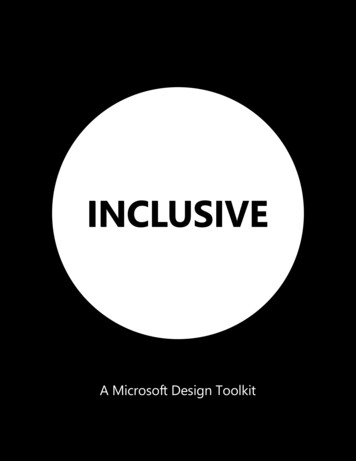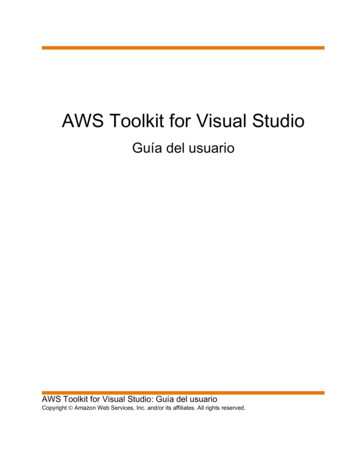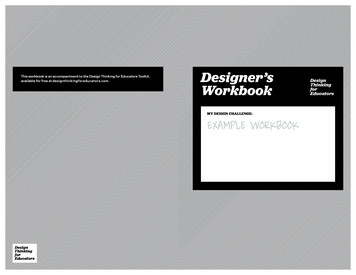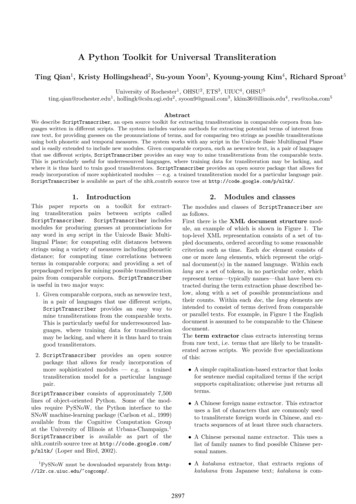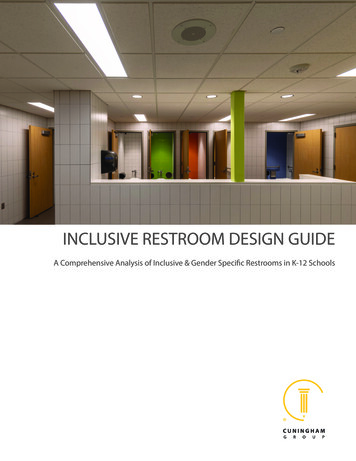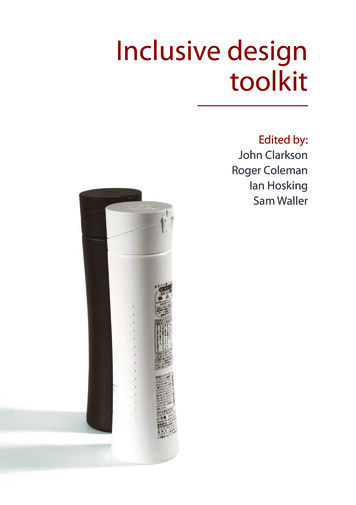
Transcription
Inclusive designtoolkitEdited by:John ClarksonRoger ColemanIan HoskingSam Waller
2007 i designPrinted and bound by xxxx, Cambridge, XXX XXXFirst published in 2007 byEngineering Design CentreDepartment of EngineeringUniversity of CambridgeTrumpington streetCambridgeCB2 1PZUKE-mail:edc-enquiries@eng.cam.ac.ukWeb: www-edc.eng.cam.ac.ukAll rights reserved. No part of this publication may bereproduced in any material form, or stored by any electronicmedium without the prior written consent of the copyrightholders (except in accordance with the provisions of theCopyright Designs and Patents Act 1988). Applicationsfor the copyright holders written permission to reproduceany part of this publication should be addressed to thepublishers.ISBN 0-0000-0000-0
Inclusive designtoolkitIf you would like to obtain a large printversion of this book, please igntoolkit.com
ForewordAcknowledgementsThis book was produced by Sam Waller. The content waswritten and edited by: Carlos Cardoso, Susannah Clarke,John Clarkson, Roger Coleman, Joy Goodman, Ian Hosking,Pat Langdon, Umesh Persad, Kay Sinclair, Sam Waller, andMatthew White.The authors are grateful to all those who helped assistedthe toolkit production, in particular: Alex Carmichael, BruceCarse, Julia Cassim, Hua Dong, Diane Douglas, Tim Lewis, AnaMedeiros, Andrew Monk, Nick Reddall, and Tom Vavik.The authors are grateful to Scope for initiating the Centrefor Inclusive Technology and Design awareness and trainingproject; which inspired this toolkit. Please see the About ussection in www.inclusivedesigntoolkit.com for more details.
ForewordForewordWelcome to the Inclusive design toolkit, commissioned byBT and developed in partnership with the i design researchteam. i designWe live in an increasingly complex and technologically richworld, and can all cite examples of products that are difficultor frustrating to use. By applying inclusive design principles,involving users in the design, and considering the needsof people with reduced capabilities, products can be madeusable, useful and desirable.
The Engineering DesignCentre, University .sagentia.comRoyal College of Art, HelenHamlyn Centrewww.hhc.rca.ac.ukCentre for Usable HomeTechnology, University ofYork www.cuhtec.org.ukApplied computing, Universityof Dundeewww.computing.dundee.ac.ukii
This toolkit was written by the Cambridge EngineeringDesign Centre, together with Sagentia and the Helen HamlynCentre. The guidance and resources contained within reflectthe outcome from i design 2, an on-going collaborativeresearch programme on inclusive design funded by theEngineering and Physical Sciences Research Council. Thei design 2 team brings together leading researchers fromthe Engineering Design Centre, University of Cambridge,Sagentia, Royal College of Art, Helen Hamlyn Centre, Centrefor Usable Home Technology, and Appplied computing,University of Dundee.The creation of the inclusive design toolkit wascommissioned and supported by BT as part of theirBetterworld eface
ContentsContentsThis toolkit has been developed to explain what inclusivedesign is, why it is worthwhile and how to do it.The book is split into four sections, where each section isintended to be self contained, as is each double page spread.In this toolkit, a ‘product’ refers to the output of designactivity, examples of which include consumer products,designer graphics, or the provision of a service.Part 1: Introduction, explains what inclusive design is, why itis worthwhile, and what corporate level strategy is requiredto encourage it. Part 2: Inclusive design process examineshow the knowledge and tools of inclusive design fit togetherwith a generic design process. Part 3: Knowledge & toolsconsiders these tools in detail. Finally, Part 4: User capabilitiesprovides detailed information on the prevalence of capabilitywithin the population of Great Britain, along with designguidance for how the capability demands of a product canbe reduced without compromising performance.iv
Part 1:IntroductionPart 2:Inclusive design processPart 3:Knowledge & toolsPart 4:User capabilities
Introduction
Part 1:IntroductionRoger Coleman, John Clarkson, Joy GoodmanIan Hosking, Kay Sinclair, and Sam Waller
IntroductionIntroduction“ Questions about whether design is necessary or affordableare quite beside the point: design is inevitable. ”- Douglas Martin (Book Design 1989)Inclusive design is a methodology that applies throughoutthe design and development process. It results in betterdesigned products that are more usable and desirable.ContentsWhat is inclusive design?Definitions of designDefinitions of inclusive designEthos of inclusive designWhat is neededExamples1-41-61-81-101-121-14Why do inclusive design?The worldwide caseThe company caseThe project case1-181-221-261-28Corporate implicationsThe SPROC modelWhat change may be requiredProduct strategy1-301-321-341-361-2
1-381-401-461-501-521-54IntroductionUseful resourcesGeneral resourcesTraining resourcesSensory resourcesCognitive resourcesMotor resources1-3
What is inclusive design?What is inclusivedesign?OverviewIt is important to understand the terms design and inclusivedesign, the ethos behind inclusive design, and the wayinclusive design contributes to product success. A numberof case studies demonstrate how inclusive design can fosterinnovation and better design.1-4
What is inclusive design?Definitions of designDefinitions of inclusive designEthos of inclusive designWhat is needed?Examples1-5
What is inclusive design?Definitions of designThe process of design may be described as“ Design . to form or conceive in the mind, invent . ”- Oxford English Dictionary (2005)“ Design is a structured creative process . All products andservices are, in effect, ‘designed’, even if not by a professionaldesigner. ”- Department of Trade and Industry (2005)“ Design is the purposive application of creativity to all theactivities necessary to bring ideas into use either as product(service) or process innovations. ”- Bessant (2005)“ The configuration of materials, elements and componentsthat give a product its particular attributes of performance,appearance, ease of use, method of manufacture. ”- Walsh (1992)“ Design is the process of converting an idea or market needinto the detailed information from which a product orsystem can be made. ”- Royal Academy of Engineering (2005)1-6
What is inclusive design?“ Design . to form or conceive in the mind, invent .” (OED, 2005)Oxford English Dictionary (2005) Oxford University Press, Oxford, UK.Department of trade and industry (2005) Economics paper 15:Creativity, design and business performance. Avail. from www.dti.gov.ukBessant J, Whyte J, Neely A (2005) Management of creativity anddesign within the firm. Advanced Institute for Management and ImperialCollege, UK.Walsh V, Roy R, Bruce M, Potter S (1992) Winning by design. BlackwellBusiness, Oxford, UK.Royal Academy of Engineering (2005) Educating engineers in design.Avail. from www.raeng.org.uk1-7
What is inclusive design?Definitions of inclusive designThe British Standards Institute (2005) definition of inclusivedesign is“ The design of mainstream products and/or servicesthat are accessible to, and usable by, as many peopleas reasonably possible without the need for specialadaptation or specialised design. ”By meeting the needs of those who are excluded fromproduct use, inclusive design improves product experienceacross a broad range of users. Put simply inclusive design isbetter design.Inclusive design is not Simply a stage that can be added in the design process Adequately covered by a requirement that the productshould be easy to use Solely about designing products for a particular capabilityloss Naively implying that it is always possible (or appropriate)to design one product to address the needs of the entirepopulationInclusive design should be embedded within the designand development process, resulting in better designedmainstream products that are desirable to own and satisfyingto use.1-8
UsersFrustratedHasDifficultyWhat is inclusive design?FindsEasyExcludedProduct experiencePhilips (2004) found that about two thirds of the populationas a whole have difficulties with technological productsAttempting to open this plastic welded packaging proved to beimpossible by hand, so this user tried more drastic measuresBritish Standards Institute (2005) British Standard 7000-6:2005. Designmanagement systems - Managing inclusive design - GuidePhilips (2004) The USA Philips Index: Calibrating the Convergenceof Healthcare, Lifestyle and Technology. A web-based survey of 1500internet users aged 18-75, www.usa.philips.com1-9
What is inclusive design?Ethos of inclusive designUser centredPeople within the population have a range of differentcapabilities and skills, past experiences, wants and opinions.Many organisations already carry out market and userresearch. Commissioning such research at the right time,with the right focus and within an appropriate designframework enables valuable insight at little, if any, additionalcost.Population awareA typical misguided viewpoint is that someone is eitherdisabled or fully able, yet a wide spectrum of capabilities isclearly apparent within any population. An understandingof quantitative population statistics can also inform designdecisions.Business focusedEvery decision made during the design cycle can affectdesign inclusion and user satisfaction. Failure to correctlyunderstand the users can result in products that excludepeople unnecessarily and leave many more frustrated,leading to downstream problems, such as increasedcustomer support requirements that can ultimately reducecommercial success. Conversely, successful implementationof inclusive design can result in a product that is functional,usable, desirable, and ultimately profitable.1-10
What is inclusive thos of inclusive design1-11
What is inclusive design?What is needed?FunctionalThe product must provide suitable features to satisfy theneeds and desires of the intended users. A product with alarge number of features is not guaranteed to be functional!UsableEasy to operate products are pleasurable and satisfying touse, while those that place unnecessarily high demands onthe user will cause frustration for many people and excludesome altogether. Frustration with, or inability to use, aproduct can lead to a negative brand image. In the extreme,prolonged difficulties with poorly designed everydayproducts can even convince people that they are no longerable to lead an independent life.DesirableA product may be desirable for many reasons, includingbeing aesthetically striking or pleasant to touch, conferringsocial status, or providing a positive impact on quality of life.ViableThe business success of a product can be measured by itsprofitability. This typically results from having a product thatis functional, usable, and desirable, and which is delivered tothe market at the right time and at the right cost.1-12
What is inclusive design?alctionFunViableD e sirSuccessfulproducta bleUs ableMeasures by which a product could be considered successful1-13
What is inclusive design?Examples: B & Q and TescoB & Q: Pressure washersA collaboration between the Helen Hamlyn Centre and B& Q looked at garden power tools. User research revealeda problem with posture for some people using pressurewashers. The researchers, now with Sprout Design,developed a new product concept that is held like a broominstead of a gun, improving posture, control and reachdramatically. The concept also incorporates a new connectorfor attaching different nozzles, placing significantly lessphysical, sensory and cognitive demands on the user.TescoTesco is the UK’s biggest private sector employer, and hasdeveloped a highly profitable web business, tesco.com,which is the world’s largest home shopping service. Theweb business posted a profit of 12.2 million in 2002-3, anincrease of more than 30 times the previous year and a rareexample of a profitable dot-com business.One early innovation was an easy-access version of the site,specifically designed for use with screen readers and slowinternet connections. This facility has now been integratedinto the main site, as a selectable setting within the user’saccount.1-14
What is inclusive design?A pressure washer that has a high physical demand, compared to aredesigned product that reduces the physical strain required to use itThe Tesco food and drink department, viewed with and withoutselecting the “Use access site” option within “My account”Top images copyright Helen Hamlyn Centre and B & Q1-15
What is inclusive design?Examples: OXO Good GripsOXO began with a few simple questions - Why do ordinarykitchen tools hurt your hands? Why can’t there bewonderfully comfortable tools that are easy to use?In 1990, the first group of 15 OXO Good Grips kitchen toolswas introduced to the US market. These ergonomicallydesigned, transgenerational tools set a new standard forthe industry and raised the bar of consumer expectation forcomfort and performance.The annual growth in sales was over 35% per year from1991 to 2002, and the line now contains more than 500innovative products covering many areas of the home. TheOXO Good Grips line has been recognized by several nationaland international organizations for superior design. Thecompany’s strategy is based on the primary goals of makingproducts that are usable and desirable.See www.oxo.com for more information1-16
What is inclusive design?The handles on these products have innovative designs that make themcomfortable to use, and the blades are functionally very effectiveThis salad spinner requires minimal capability to use, while this jughas a diagonal measuring scale that can be read from above1-17
Why do inclusive design?Why do inclusivedesign?OverviewThe primary focus of the majority of new productdevelopment projects is time and budget. However,delivering the most commercially successful product canconflict with this focus.There is often the perception that good design takes longerand costs more than bad design. Indeed that design issomething we can choose not to do and thereby reduce costand timescales. In reality, the true costs of bad design (suchas warranty returns from unsatisfied customers) emerge lateron in the product lifecycle, and have the potential to causeirreparable damage to the brand image through customerfrustration.The following pages aim to demonstrate that an inclusivedesign approach results in better products with greater usersatisfaction and greater commercial success whilst reducingproduct development risk.1-18
Why do inclusive design?The worldwide caseThe company caseThe project case1-19
Why do inclusive design?The worldwide case: Age variationThe demographics of the developed world are changing;longer life expectancies and a reduced birth rate are resultingin an increased proportion of older people within the adultpopulation.This is leading to a reduction in the Potential Support Ratio(PSR), which is the number of people aged 15-64 who couldsupport one person aged over 65. In 1950 the worldwide PSR was 12:1 In 2000 the PSR was 9:1 By 2050 it will be 4:1 globally and 2:1 in the developedworldMaintaining quality of life and independent living for thisageing population is increasingly important and will soon bean absolute necessity for all countries in both the developedand developing world.1-20
Half the adult population8485 30-3425-2920-24016-19GB 16 population (%)Why do inclusive design?12Age bandChange in UK population (%)The distribution of age within the adult population of Great Britain40Emerging markets2002-20122002-2022200Declining markets-200-1415-2930-4445-5960-7475 Age bandChange in the population within each age band over timeTop figure source: The Disability Follow-up Survey (Grundy et al. 1999)Bottom figure source: The Government Actuary’s Department1-21
Why do inclusive design?The worldwide case: Capability variationWith increasing age comes a decline in capability, yet alsoincreased wealth and free time. Where previous generationsaccepted that capability loss and an inability to useproducts and services came hand in hand, the baby-boomergeneration now approaching retirement are less likely totolerate products that they cannot use, especially if due tounnecessary demands on their capabilities.Typically, people are viewed as being either able-bodied ordisabled, with products being designed for one categoryor the other. In fact capability varies continuously, andreducing the capability demands of a product results in morepeople being able to use the product as well as increasedsatisfaction for those who previously had difficulty.When the capability demand of a product exceeds that ofthe user – they can no longer use it. Often this is seen as theperson’s fault for having a poor memory, reduced strengthor imperfect vision; inclusive design places the responsibilitywith product designers to ensure that the capability levelsrequired to use a product are as low as possible. There areseveral ways to achieve this goal without compromisingthe features or aesthetics for the more able population, thiswill be elaborated in further detail in Part 2: Inclusive designprocess.1-22
Half the adult population5085 30-3425-29020-242516-19Percentage of age bandWhy do inclusive design?75Age bandPercentage of people within each age band that have less than fullability, according to the definition used within Part 4: User capabilitiesTime or incomeDisposable incomeAverage free timeper day30Market opportunity506575AgeVariation of disposable income and free time with ageTop fig. source: The Disability Follow-up Survey (Grundy et al. 1999)Bottom fig. source: The Henley Centre, Family Expenditure Survey (1996)1-23
Why do inclusive design?The worldwide case: SimplicityEver advancing technology leads to products with evermore features, yet this wealth of features can transfer focusaway from a product that is actually useful and usable.Typical household products such as microwaves often havea bewildering array of dials, codes and buttons, so users endup trying to remember the precise action sequence requiredto achieve one desirable function, and simply ignoring therest.The foundation of a successful design is a focus on simplicity,together with an understanding of what users actuallywant from the product. Philips (2004) found that only 23%of Americans use the full range of features on most newtechnology products. 65% of Americans say they have lostinterest in purchasing a technology product because itseemed too complex to setup or operate. The fact that someproducts can be set-up and operated easily has raised the barfor what’s possible. Ease of use is so important to the public(76%) that it is now equal in importance to the dimension of‘high quality’.1-24
Why do inclusive design?Philips have marketed their brand based on simplicity whilst thismouse suffers from featuritis - it has a printer included at the sideUsing technology should not be as frustratingas trying to eat soup with a fork!Philips (2004) The USA Philips Index: Calibrating the Convergenceof Healthcare, Lifestyle and Technology. A web-based survey of 1500internet users aged 18-75 www.usa.philips.com1-25
Why do inclusive design?The company caseSuperior company performanceThe key test of the value of design from a businessperspective is whether a design aware company outperformsits competitors who are not. The Design Council (2005)showed that an index of design aware companiesoutperformed the FTSE All share by over 200% in both bulland bear markets over a 10 year period.There are clearly other indicators of good management apartfrom design, however, the evidence that ‘good design is goodbusiness’ is compelling.Corporate level risk managementDesign is not optional. It is an inevitable consequence ofspecifying or developing a product or service. The question iswhether your design is good, bad or indifferent. Good designhelps to manage development risk, asking Are you building the right products (or services)? Are you building the product right?These two questions are fundamental to understanding andmitigating risk. It is imperative that the business at a strategiclevel empowers those developing and managing products touse design effectively to reap the benefit at a corporate level.See the Corporate implications section for more detail on thisissue.1-26
Why do inclusive design?Design IndexIndex valueFTSE All earThe Design Council (2005) showed that an index of design aware companies outperformed the FTSE All share by over 200% in both bull and bearmarkets over a 10 year period“ Good design is not simply about aesthetics or making aproduct easier to use . it’s an essential part of thebusiness. ”- Tony BlairDesign council (2005) Design Index: The impact of design on stockmarket performance. Available from www.design-council.org.uk1-27
Why do inclusive design?The project caseGood design brings a number of benefits to a project. Project teams have a clear focus and objective Design decisions are made in an informed and decisivemanner, without relying on the project team’s ‘best guess’The cost of change increases exponentially throughout thedesign and development lifecycle; hence these costs can beminimised by ensuring a thorough understanding of the realuser and business needs at the start of the design process,and correctly translating these needs into an appropriaterequirements specification.Design decisions based on appropriate insight into userneeds are likely to carry less risk, and ultimately lead to Clear differentiation from the competition Customer satisfaction and loyalty Market success1-28
Why do inclusive design?Design stageRelative cost of changeConcept1Detail design10Tooling100Testing1000Post-release10000The cost of making changes accelerates rapidly as release approachesFigure source: Mynott C et al (1994) Successful product development:Management case studies. M90s Publications, London1-29
Corporate implicationsCorporateimplicationOverviewA desire to implement inclusive design at a project orproduct level is often hampered (or stopped) by corporatelevel issues. In order for genuine and repeatable success tobe realised at a project level, there are likely to be a numberof implications for the business.The SPROC (Strategy, Process, Resources, Organisation, andCulture) model considers issues that are key to a business’ability to deliver inclusive design. It is used here to showhow senior-level buy-in and support can affect strategic andorganisational change that will ultimately cascade down tochange at the tactical/project level.It is unlikely that one product can fit all, but successfulmanagement of a product portfolio can be an excellentmeans to deliver inclusive design.1-30
Corporate implicationsThe SPROC modelWhat change may be required?Product strategy1-31
Corporate implicationsThe SPROC modelInclusive design can be encouraged by considering theSPROC (Strategy, Process, Resources, Organisation, andCulture) model. It is a simple way to represent the elementsof a business that can have an impact on its ability toimplement inclusive design.Strategy: Does the high-level business strategy support andencourage inclusive design?Process: Do existing innovation and development processesincorporate inclusive design considerations. If so, do theyfunction well?Resources: Does the organisation recognise what resources(internal or external) are required to successfully deliverinclusive design?Organisation: Do organisational structures, reward systems,and metrics encourage the behaviours required for effectiveimplementation of inclusive design?Culture: Does the combination of organisational structure,staffing, task design and internal brand values provide for thedesire and capability to deliver inclusive design?1-32
Corporate bleeovprResourcesCultureOrganisationTo implement inclusive design, it is necessary to have a strategy thatimproves the design process, enables sufficient resources, incentivises theorganisation, and promotes the right culture1-33
Corporate implicationsWhat change may be required?When senior business management have accepted the valueof inclusive design principles and outputs, they are wellplaced to affect change at the strategic and organisationallevels. Of greatest value is their ability to form a strong linkbetween business strategy and inclusive design.Management support is also required to prevent too narrowa focus on time and budget as measures of developmentproject success. This can inhibit consideration of downstreamproblems and their associated costs during the earlier partsof the design process, when changes can most easily beimplemented. Examples of such costs include no-fault foundwarranty returns, and customer support.Without senior support, buy-in and action, the successfuldelivery of inclusive design is likely to rely on localchampions in the business, who actively change approacheswithin their sphere of influence.1-34
Corporate implicationsExisting design processInclusive design processAn effective inclusive design process can bebuilt upon an existing design process1-35
Corporate implicationsProduct strategySatisfying a range of different users or markets can often beachieved by developing a corresponding range of productsin the form of platforms and portfolios. One product may notfit all, but many products can.Companies need to manage their portfolios to ensure thatthe range of products and associated feature sets offeredmatches the spread of capabilities amongst their chosentarget population.For any particular product or feature set, the principles ofinclusive design can help to extend the potential marketby ensuring that features are intuitive, easy to learn andsatisfying to use, without compromising the desirability forthe original market. Tools that can be used to manage theoverall product strategy include Portfolio management Product and technology platforms Style guidesFor more detail on each of these, see the Product strategysection within Part 3: Knowledge & tools.1-36
Corporate implicationsPopulation capabilityMarket segmentationPortfolio managementPortfolio 1Portfolio 2Portfolio 3Style GuidePlatform AProductProductProductProductProductPlatform BProductKnowledge of population capability statistics and careful analysis ofmarket segments can help to provide targets for specific products, andmanage these products using platforms and portfolios1-37
Useful resourcesUsefulresourcesLinksOverviewThis section contains references that may be usefulto provide further information. They are grouped intocategories that loosely correspond with the sections of thistoolkit. General resources highlights books, websites andconferences relevant to inclusive design Training resources indicates participative activities whereyou can learn more about inclusive design Sensory resources are useful to find out more about visionand hearing Cognitive resources are useful to find out more aboutthinking and communication Motor resources are useful to find out more aboutlocomotion, reach & stretch, and dexterity1-38
Useful resourcesThe Design Council’s inclusive design websitewww.designcouncil.org.uk1-39
Useful resourcesGeneral resources: BooksCard SK, Moran TP, Newell A (1983)The psychology of human-computer interaction. LawrenceErlbaum Associates, Hillsdale, NJ, USAApplying psychology to design to make interfaces that areeasy, error-free and enjoyable.Martin J, Meltzer H, Elliot D (1988)The prevalence of disability among adults. Her Majesty’sStationery Office. ISBN 0-11-691229-4Report summarising the results from the 1986/87 survey ofdisability in Great Britain. Contains descriptions of the scalesthat are used to measure ability/disability in this toolkit.Grundy E, Ahlburg D, Ali M, Breeze E, Sloggett A (1999)Research report 94 - Disability in Great Britain. CorporateDocument Services, London, UK. ISBN 1-84123-119-3Report summarising the results from the 1996/97 disabilityfollow-up to the family resources survey, the statistics fromwhich are used throughout this toolkit.British Standards Institute (2005)British Standard 7000-6:2005. Design management systems Managing inclusive design - GuideGuide to managing inclusive design at the organisational andproject levels.1-40
Useful resourcesKeates S, Clarkson J (2003)Countering design exclusion: An introduction to inclusivedesign. Springer, London, UKAn introduction to designing more inclusive products.Clarkson J, Coleman R, Keates S, Lebbon C (eds) (2003)Inclusive design. Springer-Verlag, London, UKThe business case and design toolkit for inclusive design.Preiser W and Ostroff E (eds) (2000)Universal Design Handbook. McGraw Hill, New York, USAA comprehensive academic reference book.Pirkl JJ (1994)Transgenerational design. Van Nostrand Reinhold,New York, USAExamples of age-friendly products.Coleman R (2001)Living Longer. Design Council, London, UKAn introduction to the context of inclusive design.Story MF, Mueller JL, and Mace RL (1998)The Universal Design File. The Center for Universal Design, NCState University, North Carolina, USAA guide for studying and evaluating universal design.1-41
Useful resourcesGeneral resources: WebsitesDesign Council About: Inclusive Designwww.designcouncil.org/A comprehensive knowledge-base covering key aspects ofi
Design Centre, together with Sagentia and the Helen Hamlyn Centre. The guidance and resources contained within reflect the outcome from i design 2, an on-going collaborative . Oxford English Dictionary (2005) Oxford University Press, Oxford, UK. Department of trade and industry (2005) Economics paper 15:


